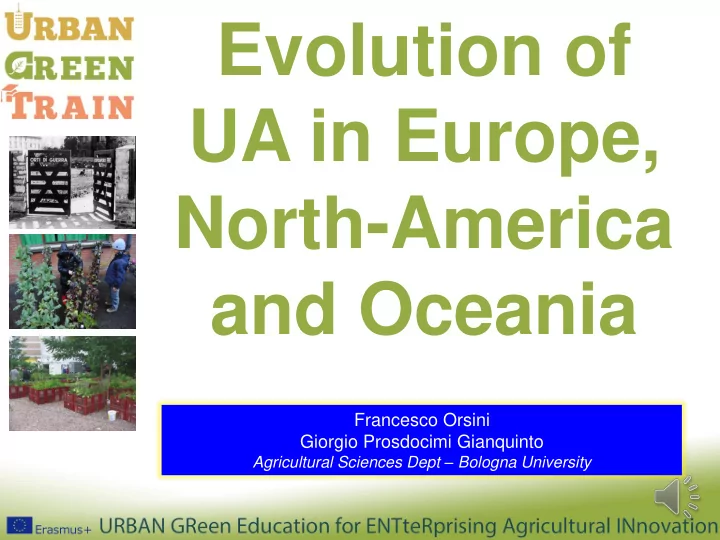

Evolution of UA in Europe, North-America and Oceania Francesco Orsini Giorgio Prosdocimi Gianquinto Agricultural Sciences Dept – Bologna University
Medieval Urban Horticulture Gardens nearby the city walls Moved onto respect areas within walls, greater defence and reserve of food in case of war.
Urban Horticulture during the industrial revolution Gardens nearby factories. Improve life of the workers and reduce poverty and malnutrition.
Kle leingärten, , Schrebergärten (Germany) ) First association of people, families and small communities involved in urban gardening, established in 1864, by doctor Daniel Gottlob Moritz Schreber (1808 - 1861). Today, urban gardens are still called " Schrebergärten ". Schrebergarten – Josef Hegenbarth, 1930. Kleingärten, 1952 Staatliche Kunstsammlungen Dresden (Deutsche Fotothek)
Jardins ouvriers (F (France) Saint Etienne, France, 1930- ’ 40
Migrant gardens (USA, Australia) Visalia, California, USA, c. 1940 La Perouse, Sidney, Australia, c. 1950
Orti Operai (It Italy) Orti del Dopolavoro – c. 1935 -'40 (Archivi Edison)
Urban horticulture during the 2 nd world war Garden cultivation in cities For promoting food security for citizens and the soldiers. Promoted by Propaganda for VICTORY GARDENS governments and DIG FOR VICTORY in USA and England,’40.
Urban horticulture during the 2 nd world war In United States of America, Victory Gardens are promoted In 1943 20 millions of gardens in USA an Propaganda production of about 8 VICTORY GARDENS million tons, about 10% of in USA,’40. the requirements.
The fi fift fties Europe comes out of the war poor, and reconstruction forgot the crucial role played by urban agriculture in the food security in previous years URBAN PLANNING and the ECONOMIC BOOM pave the way for colonizing all city green spaces and turning them into concrete lands.
The seventies The ecologist turn. First community gardens are appearing, as a form for self- determination, self- management and independence from the People’s Park, in a vacant land in the University of Berkeley market
Liz Christy Garden In the seventies, the crisis resulted in thousands of empty buildings: more than 25’000 in the only city of New York Community gardens, such as the Liz Christy Garden, start to appear. Liz Christy Garden, NYC, 1973.
The seventies Guerrilla Gardening Reaction to the indifference of public institution to the decadence and degradation of periurban lands. Adam Purple, the father of Guerrilla First form of non-violent Gardening. political gardening.
Adam Purple Garden of Eden Realized under the guide of Adam Purple, was removed in 1986 to create social housing buildings Garden of Eden in the East-Side Manhattan
Adam Purple Garden of Eden The artist George Bliss disseminated footprints guiding the visitors to the place where the George Bliss, NYC. garden was
The eig ighties Factors limiting the development of urban horticulture: 1) Media promoted terror for contamination: only food produced in factories is healthy; 2) Cities transforming and fight for available space: prices established by the market rather than sustainability laws. Diffusion of illegal gardens
The eig ighties Features of an illegal garden 1) In marginal and polluted areas, (wastelands, nearby main roads); 2) Only productivity objective, no care is given to aestetic or cleaning; 3) Pesticide intensive production, not organic management. Bad pubblicity to urban horticulture
The eig ighties Illegal gardeners continue their fight (ItaliaNostra, 1982): 1) In Milan, Italy, more than 800 ha, 25% of the local production; 2) Managed by factory workers, but also retired and students 3) Each garden 80 to 120 m 2 Unstoppable growth. City councils cannot ignore it anymore!
The eig ighties In Modena, in 1980 the first italian regulation of social garden is established. However, administration still see UH as something for elder and poors: realised in already green lands, open only to people above sixty years of age, not family presence admitted.
The nineties … in in USA First institutional and political recognition 800 Community gardens in New York, establishment of the public agency Green Thumb , long term authorisation of public lands.
The nineties … in UK In UK Constitution of the Federation of City Farms and Community Gardens , promoting multifunctional agriculture in Garden associated to the Federation of City cities. Farms and Community Gardens, UK.
The nineties … in Italy In Italy Constitution of ANCESCAO (National Association of Social Centres, Elderly and Gardens), favouring social agriculture against solitude and marginalization.
Social gardens in Italy
Social gardens in Italy
Urban agriculture in in the th Century 21 th 21 ry Garden as way for innovation Productivity Aesthetic
Urban Agriculture in in the th Century 21 th 21 ry Michelle Obama, implementing a vegetable garden at the Whitehouse.
Urban agriculture in in the th Century 21 th 21 ry LAND ART
Urban agriculture in in th Century the 21 th ry UA for inclusion and socialisation at Ton Steine Garten, Berlin, Germany.
Urban agriculture in in th Century the 21 th ry UA for recreation and wellbeing at Prinzessinen garten, Berlin, Germany.
Urban agriculture in in th Century the 21 th ry UA for inclusion and socialisation at Allmende Kontor, Berlin, Germany.
Urban agriculture in in th Century the 21 th ry UA for inclusion and socialisation at Gandusio rooftop garden, Bologna, Italy.
Evolution of UA in Europe, North- America and Australia: Bullet Points • Urban agriculture has been integrated into European cities since medieval time • During industrialization gardens were found nearby factories for workers leisure and food security • During the war UA was crucial for food security • From the fifties, as urbanization grew, UA presence was reduced in most cities • From the seventies the ecologist turn led to spread of UA initiatives, that were then recognised from administrations starting from the eighties.
Evolution of UA in Europe, North- America and Australia: Bullet Points • From the beginning of the 21 st Century, UA is being promoted as a crucial element in most world cities, for the multifunctional role it can play.
Recommend
More recommend